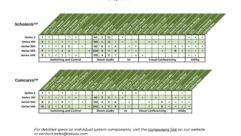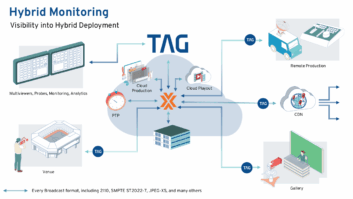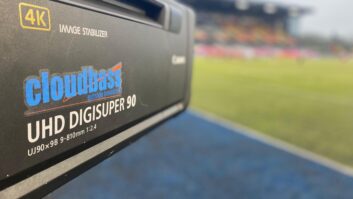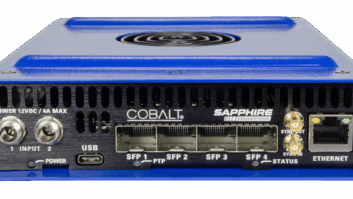
Product Review: Sabine SWM7000
Apr 1, 2004 12:00 PM,
By John McJunkin
The SWM7000 system includes the SW72-NDR receiver, an SW70-HD5 handheld microphone, and the SW70-T belt-pack transmitter.
Sabine recently introduced the 2.4 GHz SWM7000 Series Smart Spectrum True Mobility Wireless System, which is available with combinations of various elements. The kit that I reviewed shipped with the SW72-NDR 2-channel receiver, the SW70-HD5 handheld microphone/transmitter, the SW70-T belt-pack transmitter, and the SVT70BW-TA4 headset microphone. This is a high-quality system that yields clear, wide-bandwidth audio at distances of up to 100 meters, if line of sight is possible. Sabine is one of a number of manufacturers abandoning the 900 MHz band for the less crowded 2.4 GHz domain, and it cites a list of seven “challenges” as the underlying philosophy for the development of this new system. The challenges reflect such issues as available spectrum, transmission/reception reliability, battery failure, feedback issues inherent to wireless mics, governmental regulations, fidelity and frequency response, and limited interchangeability of proprietary technology.
MEETING THE CHALLENGES
Over the years, wireless manufacturers have continually increased the carrier frequency of their systems. The recent breakthrough into the 2.4 GHz band has two positive effects; the below 1 GHz bands are earmarked for high-power RF, and above 2.4 GHz is restricted to low-power applications, thus inherently reducing interference. The other advantage is more bandwidth, enabling more simultaneous channels. The 2.4 GHz band is also approved for use internationally, solving problems for overseas tours. The use of the higher band contends with Sabine’s first two challenges (and fifth challenge, as well.) The issue of battery failure is met with Sabine’s Tireless Wireless, the use of nickel-metal-hydride rechargeable batteries, which are charged right inside the units, obviating the need to remove, recharge, and replace. Sabine’s challenge of feedback is combated with some pretty slick digital signal processing (DSP) that I’ll discuss in greater depth momentarily. The issue of fidelity is met to a certain extent by the use of the higher carrier frequency but also by forward strides in the design and components. Finally, Sabine’s proprietary technology issue alludes to the preference of artists for certain “classic” or “standard” microphone products. The SWM7000 series allows emulation of a handful of popular live sound mics that artists, engineers, and tour managers prefer. Sabine has definitely put some thought and effort into contending with these issues, and the product and consumer benefit from it.

THE RECEIVER
The SW72-NDR receiver is a 2-channel rackmount unit that sports some pretty amazing features. Seventy channels of operation are available, so that with multiple units, you could literally have that many signals emanating from the stage. Sabine has a proprietary feedback-extermination feature known as
FBX
, which uses super-narrowband notches under fast computer control to not only wring out monitors prior to performance but also work dynamically in real time during performance. Another slick DSP function calls Antares’ Mic Mod to mind. Certain artists and engineers like certain mics and may show some disdain when you inform them that they’ll be using something new and unfamiliar. This system enables the emulation of a number of popular mics, including presets for Shure’s SM58 and Beta 58, Audio-Technica’s ATM-41A, and AKG’s D-3800, intended for Sabine’s dynamic capsules. Emulations of Shure’s Beta 87A, AKG’s C535EB, and AT’s ATM 89R are for usage with Sabine’s condenser capsules. An effective no-muss, no-fuss de-esser is included in the receiver, with a single cut knob to control it. A compressor is built in as well, with front-panel controls for ratio, threshold, and attack time. It doesn’t sound like a classic tube compressor, but it affords nice gain control for vocalists who have none. The receiver has a readable LCD display for each channel, showing RF signal strength, remaining battery strength of the associated transmitter; audio level; gain reduction of the compressor; a numerical display to show the channel number or compression ratio, for instance; and a function display that shows text pertaining to the currently selected parameter.
THE MICS
The kit that I reviewed shipped with the SW70-HD5 handheld microphone, which features an Audix OM5 capsule. The fidelity of this mic is quite high, with inherently low self-noise, and due to Sabine’s proprietary transmission system, all the bandwidth is represented at the receiver. The combination of the SWT56W-TA4 head-worn mic and the SW70-T belt-pack transmitter proved solid, as well. The mic is unobtrusive, and in order to avoid a large capsule in the face of the performer, an omnidirectional microcapsule condenser extends a short distance below and in front of the right earlobe. The omnidirectional nature of the head-worn mic requires some careful monitor wringing, but the system’s FBX feedback exterminator goes a long way to help make that happen.
REMOTE CONTROL
In addition to all the other nice features, the SWM7000 system enables remote control. The receiver has RS-232 and USB interfaces to allow connection to a host computer and RS-485 network connections (RJ-45 jacks), enabling daisy-chaining of as many as 35 receivers. The remote-control software yields deeper control of the parametric filters of the FBX system, high- and lowpass filters (accessible only by computer), compressor release time and knee characteristics, a visual report of signal strength for 70 channels, preset storage, channel muting, custom onscreen naming of transmitters, expanded displays, customizable front-panel lock settings, and the ability to print a hard copy of all parameters. The software is a welcome addition but probably not a necessity for a small system. If you are using a significant number of channels, however, I don’t know how you could get along without the computer.

SOUND QUALITY
I plugged the system in and walked around with the handheld mic to get a grasp on the subjective quality of the sound. The one thing that struck me as distinct with this system is the low end. Sabine took this aspect seriously. I’m accustomed to my old 900 MHz system, which sounds nice but just doesn’t represent the low end. With the Sabine, it was all there, so much so as to fool the seasoned engineer into believing that this is a cabled mic. The high end sounds great, too. The handheld mic was a dynamic unit but afforded plenty of detail in the high end like a condenser. The de-esser is effective and easy to use. But don’t expect any warmth or fullness from the compressor — it’s not that kind of circuit. This is strictly for level control, but it does the trick. The FBX feedback extermination is quite effective and, when used in conjunction with your skilled monitor wringing, should yield you some pretty respectable gain. The mic-modeling DSP is a nice gadget. I didn’t have the opportunity to A/B with the classic mics, but to my ear, the SM58 and Beta 58 emulations sounded real enough.
CHALLENGES? NO PROBLEM
The Sabine SWM7000 wireless system is a solid value. The quality of the audio is high — enough to fool you into believing that you’re hearing a cabled microphone. It’s really easy to use and can enable some pretty sophisticated control over a complex system, if that’s your requirement. Sabine smartly enumerated the challenges associated with wireless systems and developed solutions to meet each of them head-on. It has an excellent product here. I have only one problem now: I don’t know how I’m going to break the news to my old 900 MHz system that it will be going to a new home.
PRODUCT SUMMARY
Company:
Sabine,
Product:
SWM7000
Pros:
High-quality system with numerous value added features; not superexpensive.
Cons:
Operation of multiple units with a computer could get quite complex.
Applications:
Appropriate for use in all typical P.A. situations.
Price:
SW72-NDR: $1,659.99; SW70-HD5: $499.99; SW70-T: $324.99; SWT56W-TA4: $149.99; SVT70BW-TA4: $299.99
SPECIFICATIONS
Carrier Frequency Range
ISM band 2,400-2,483.5 MHz
Frequencies
70 preprogrammed
Oscillation Mode
PLL synthesized
Receiving Mode
true diversity
Sensitivity
6 dBV at S/N over 70 dB
Dynamic Range
>100 dB
S/N Ratio
95 dB (typical)
THD
<0.1%
Frequency Response
20 Hz-20 KHz, ±1 dB
Antennas
2, ¼ wavelength, 50ž
Power Supply
100-240 VAC 50-60 Hz
Working Range
>100 meters
Outputs
balanced XLR and TRS, mic or line level, RS-232 and RS-485 serial interface, digital-audio output with sync input
SW70 SERIES HANDHELD MICROPHONES
Telemetry
Battery voltage, mute status, capsule type
Programmable On/Off Switch
Battery
Sabine rechargeable or one 1.5V alkaline C cell
Rechargeable Battery Life
8 hours per charge, 500 charge cycles (typical)
Alkaline Battery Life
14 hours (typical)
SW70 SERIES BELT-PACK TRANSMITTER
Telemetry
battery voltage, mute status
Programmable On/Off Switch
Battery
Sabine rechargeable or two 1.5V alkaline AA cells
Rechargeable Battery Life
10 hours per charge, 500 charge cycles (typical)
Alkaline Battery Life
14 hours (typical)
DIGITAL SIGNAL PROCESSING
FBX Filters
10 independent digital filters per channel, controlled automatically from 20 Hz-20 KHz
Digital Compressor/Limiter
Automatic De-Esser
Microphone Supermodeling
10 user presets
Dimensions
1U rackmount, 19″ × 1.75″ × 9″
Weight:
5.3 lb.










